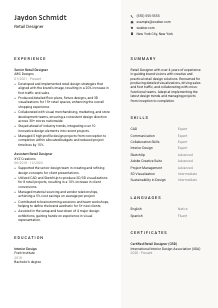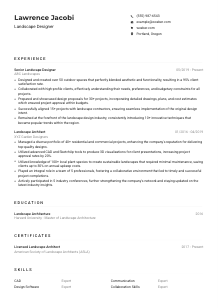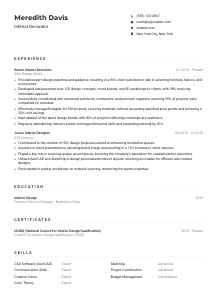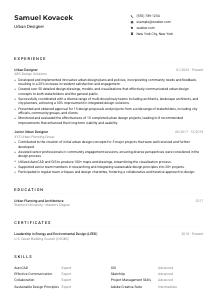Retail Designer Resume Example
Crafting store layouts, but your resume doesn't grab shopper attention? Indulge in this Retail Designer resume example, styled with Wozber free resume builder. Discover how to thread your design finesse with job aesthetic, making sure your career stands out just as strikingly as a well-dressed mannequin in a shop window!

How to write a Retail Designer Resume?
Are you ready to make your mark as a Retail Designer but find the crowded job market daunting? Your resume is not just a document; it's your personal exhibit, beautifully showcasing your design flair and professional achievements. With Wozber's free resume builder at your side, you're about to embark on a journey to create an ATS-compliant resume that mirrors the job you're aiming for.
This guide, meticulously crafted for the aspiring Retail Designer, will navigate through optimizing each section of your resume, ensuring it resonates loudly in the competitive design world. Let's set the stage for a resume that not only ticks all the boxes but does so with style and precision.
Personal Details
First impressions matter, especially in the design world. The Personal Details section of your resume is akin to the opening of a grand exhibit–it invites potential employers into your world. By tailoring this section specifically for the Retail Designer role, you're laying down a strong foundation that aligns with the job's demands.
1. Make a Statement with Your Name
Think of your name as a brand logo; it should grab attention. Opt for a clear, legible font that stands out but remains professional. A touch more prominent than the rest, it sets the stage for your personal brand.
2. Showcase Your Title
Following your name, proudly display the title 'Retail Designer,' echoing the position you're vying for. This preps the reader on what to expect and demonstrates alignment with the job at hand.
3. Contact Information Clarity
Ensure your contact info is spotless. A professional email and a reliable phone number are non-negotiable. Double-check for accuracy; an oversight here could mean a missed opportunity.
4. Confirm Your Locale
"New York City, New York" is not merely an address; it's a tick on the job's checklist. It communicates readiness and eliminates any concerns about relocation or commuting right off the bat.
5. Link to Your Portfolio
Given the visual nature of your profession, including a link to your professional online portfolio or LinkedIn profile can significantly bolster your appeal. Ensure it's current and reflects your resume, providing a seamless narrative of your career.
Takeaway
Revise your Personal Details section, ensuring it serves as a clear, concise introduction. This is your professional greeting, setting the tone for the narrative of your design career. Make it insightful, precise, and aligned with the Retail Designer role you're eyeing.





Experience
The Experience section is where your career narrative unfolds, revealing your journey through the realm of retail design. Here, exhibiting roles that weave seamlessly with the Retail Designer position's requirements is your key to capture the employer's imagination.
- Developed and implemented retail design strategies that aligned with the brand's image, resulting in a 20% increase in foot traffic and sales.
- Produced detailed floor plans, fixture designs, and 3D visualizations for 15+ retail spaces, enhancing the overall shopping experience.
- Collaborated with visual merchandising, marketing, and store development teams, ensuring a consistent design direction across 30+ stores nationwide.
- Stayed ahead of industry trends, integrating over 10 innovative design elements into recent projects.
- Managed 5 high‑profile design projects from conception to completion within allocated budgets and reduced project timelines by 15%.
- Supported the senior design team in creating and refining design concepts for client presentations.
- Utilized CAD and SketchUp to produce 2D/3D visualizations for 8 retail projects, resulting in a 10% increase in client conversions.
- Managed material sourcing and vendor relationships, achieving a 5% cost savings on average per project.
- Contributed to brainstorming sessions and team workshops, helping to define the brand aesthetic for 5+ new clients.
- Assisted in the setup and tear‑down of 4 major design exhibitions, gaining hands‑on experience in visual representation.
1. Dissect Job Requirements
Begin with a keen eye, identifying elements from the job description, such as 'Develop and implement retail design strategies,' and map your experience directly to these tasks, creating a narrative thread that binds your career to the job's fabric.
2. Present a Story of Growth
Structure your experiences from most recent to oldest, but more importantly, narrate a story of progression. Show how each role has been a step towards becoming the Retail Designer you are today, emphasizing growth and learning at each point.
3. Employ Achievement-Oriented Statements
Rather than listing duties, focus on accomplishments. For instance, "Developed floor plans increasing sales by 20%" not only aligns with the job requirement but vividly paints your impact. Wherever possible, quantify your achievements to lend them weight.
4. Quantify Success
Numbers speak a design language of their own. They quantify your impact, offering concrete proof of your effectiveness. Whenever possible, imbue your achievements with metrics, showcasing your contributions in a universally understandable format.
5. Relevance is Key
In design, every element serves a purpose; similarly, every point in your resume should directly contribute to the narrative of you as the perfect Retail Designer. Trim the excess and keep only the most relevant and compelling experiences.
Takeaway
Each bullet in your Experience section is a testament to your suitability for the role. Think like a curator, selecting only the most relevant and impactful pieces for your exhibit. Tailor, quantify, and ensure each achievement not only speaks to your past but also your future as a Retail Designer.
Education
The Education section of your resume is your academic foundation, underscoring your qualifications for the Retail Designer role. Let's ensure this section is polished to reflect not just where you've been, but where you're poised to go in your career.
1. Spotlight the Essential Credential
Right off the bat, align your degree with the job's requirements, for instance, a "Bachelor's degree in Interior Design." This not only showcases your specialized background but also ticks a vital box in the hiring criteria.
2. Embrace Simplicity in Presentation
Maintain clarity and conciseness in this section. A straightforward listing of your degree, field of study, institution, and graduation year keeps this section digestible and streamlined, while fully communicating your academic credentials.
3. Tailor for Relevance
While the name of your degree is important, presenting it in a way that resonates with the Retail Designer role is crucial. Use wording that echoes the job description, ensuring an unmistakable alignment between your academic background and the job's demands.
4. Optional: Highlight Pertinent Courses
In situations where your degree is broader or tangentially related to Retail Design, mentioning specific courses that hone in on skills or knowledge relevant to the job can provide additional depth to your qualifications.
5. Showcase Achievements and Extracurriculars
If you have any academic honors, relevant club memberships, or project work that directly aligns with retail design, include these details. They add color and depth to your academic profile, illustrating a broader engagement with your field.
Takeaway
Your Education section is a pillar of your resume, grounded in relevance and polished to reflect your foundation in retail design. It's not just about where you've studied, but how your academic journey shapes you as a candidate for the Retail Designer role.
Certificates
Certificates are your badges of continuous learning and excellence in specific skill areas. They can significantly bolster your profile, especially when closely aligned with the Retail Designer role's demands. Let's identify and present your certificates in the best light.
1. Match Job Requirements
While the job posting may not always explicitly mention required certifications, highlighting relevant ones, like a ‘Certified Retail Designer' certificate, can underscore your commitment to the profession and readiness for the role.
2. Selectively Showcase Certificates
List only those certifications that directly complement the role of a Retail Designer. This ensures the hiring manager's attention is captured by your most pertinent qualifications, making for a clean, compelling narrative.
3. Detail with Dates
Indicating when you received your certification can be particularly informative, especially for recently earned accolades, signifying your commitment to staying current in your field.
4. Commit to Continuous Learning
The design world is dynamic, with trends and tools evolving. Show a commitment to your professional growth by pursuing ongoing learning opportunities and staying ahead in your field.
Takeaway
Certificates are a testament to your dedication and skill enhancement. Curate this section to highlight those achievements that resonate with the Retail Designer role, painting a picture of continuous growth and a commitment to excellence in your craft.
Skills
Skills are the colors on your palette, each one contributing to the masterpiece that is your candidacy for the Retail Designer role. Hard and soft skills alike define your professional landscape; let's ensure they're presented in a way that captivates and convinces.
1. Extract from the Job Description
Begin by identifying both the explicit and implicit skills mentioned in the job description. For instance, proficiency in CAD and SketchUp, alongside excellent communication skills, are directly aligned with the demands of a Retail Designer.
2. Prioritize and List
Select skills that directly match the job description, laying them out in a manner that's both neat and prioritized according to their relevance. This strategic display ensures the hiring manager immediately sees your fit for the role.
3. Balance Hard and Soft Skills
While technical proficiency is crucial, soft skills like communication and collaboration are equally important, especially in a collaborative and client-focused field like retail design. Ensure your skillset is balanced and comprehensive.
Takeaway
Your Skills section is a critical exhibit of your professional capabilities. Approach it with the same level of design sense you would a project, ensuring each skill listed is not just a reflection of your abilities but a statement of how perfectly you fit the Retail Designer role.
Languages
In a globally connected market, the ability to communicate across cultural and linguistic barriers can be a significant advantage. Let's finesse your Languages section to reflect the global scope of Retail Design and your proficiency in navigating diverse markets.
1. Align with Job Specifications
Starting with the requirements, "English proficiency" is explicitly mentioned as a key skill. Position this at the forefront of your languages list, denoting your native or fluent command, as per your actual proficiency.
2. Enumerate Other Languages
While the job might specify certain languages, don't hesitate to list others you're proficient in. This showcases your versatility and readiness to engage in diverse environments, a plus in the design world where inspiration knows no boundaries.
3. Honest Proficiency Levels
Clearly demarcate your language skills using terms like 'Native,' 'Fluent,' 'Intermediate,' and 'Basic.' This transparency ensures that expectations are set accurately, laying a foundation of trust.
4. Consider the Role's Scope
For positions like Retail Designer, which may involve interactions across different regions or with international clients, highlighting your multilingual abilities can significantly amplify your appeal.
5. View Languages as Opportunities
Each language you speak opens up a new realm of possibilities. Whether your proficiency level is basic or native, each linguistic skill is a doorway to broader understanding and global inclusivity.
Takeaway
Your linguistic skills are not just part of your resume; they're bridges to the world. Treat them as such, showcasing your ability to communicate and connect across cultures. This section is your ticket to a global stage, proving that you're not just a designer but a world-wise communicator.
Summary
Your summary is the spotlight moment before the curtain rises on the rest of your resume. It's your chance to entice, to hint at the depth of your professional journey. For a Retail Designer, this is where you distill your essence, capturing the imagination of your future employer.
1. Grasp the Job's Core
Dive deep into the job requirements, understanding the heart of what makes a successful Retail Designer. This intuitive grasp allows you to sculpt a summary that speaks directly to the needs and aspirations of your potential employer.
2. Begin with Your Credentials
Open with a statement that encapsulates your professional identity and breadth of experience, for instance, 'Retail Designer with over 4 years of experience in guiding brand visions with creative and practical retail design solutions.' This sets the stage with clarity and confidence.
3. Highlight Your Prowess
Meld your skills and achievements into a compelling narrative. Mention your knack for driving sales and foot traffic, your collaborative spirit, and your adaptability in integrating the latest design trends. This showcases the unique blend that makes you the ideal candidate.
4. Concision is Key
Keep it succinct. Your summary is a teaser, inviting the reader to explore the detailed narrative of your resume. Aim for 3-5 lines that powerfully encapsulate your professional essence, driving interest and anticipation.
Takeaway
Your summary is your personal brand slogan. A compelling, concise encapsulation of your professional journey and your fit for the Retail Designer role, it should intrigue and invite deeper exploration. Tailor it with precision; let it be a beacon that guides the hiring manager towards choosing you.
Launching Your Retail Designer Journey
By now, you have crafted a Retail Designer resume that not only aligns with the job's requirements but also showcases your individuality within the field. Remember, your resume is your narrative, a curated collection of your professional milestones. Use Wozber's free resume builder, including its ATS-friendly resume templates and ATS resume scanner, to ensure your resume not only reaches the hiring manager's desk but also resonates with them. The design world is competitive, but with a resume that reflects both your competence and creativity, you're ready to stand out.
Here's to the next chapter in your Retail Design career. Shine bright and design your path forward.

- Bachelor's degree in Interior Design, Architecture, or related field.
- Minimum of 3 years of experience in retail or commercial design.
- Proficiency in CAD, SketchUp, Adobe Creative Suite, and other design software.
- Strong understanding of brand identity, consumer behavior, and retail trends.
- Excellent communication, presentation, and collaboration skills.
- English proficiency is a key skill for this position.
- Must be located in New York City, New York.
- Develop and implement retail design strategies that align with the brand's image and business goals.
- Produce detailed floor plans, fixture designs, and 3D visualizations of retail spaces.
- Collaborate with cross-functional teams including visual merchandising, marketing, and store development to maintain design consistency.
- Stay updated with the latest trends and materials, ensuring a fresh and innovative design approach.
- Manage projects from conception to completion, ensuring timelines and budgets are met.















